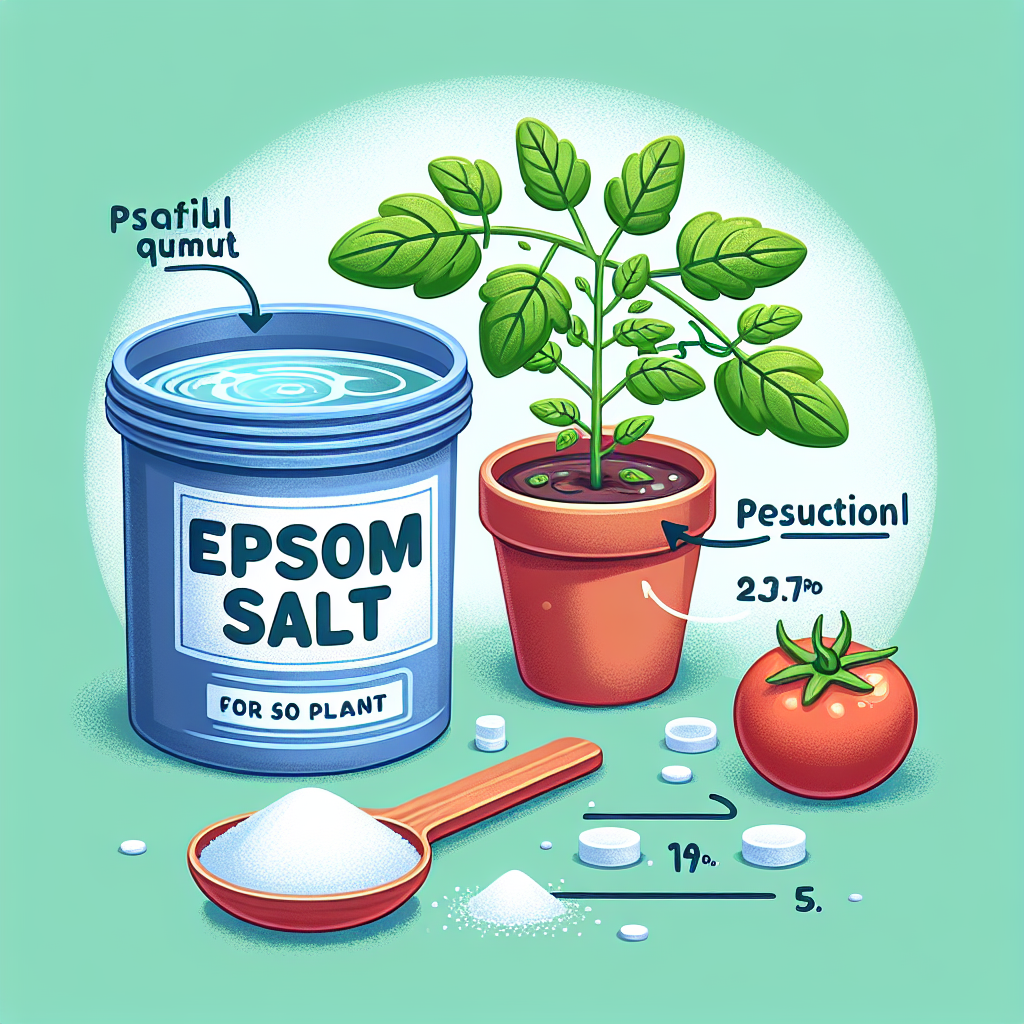
How much epsom salt for plants
Understanding Epsom Salt: A Natural Booster for Plants
When it comes to gardening, many enthusiasts are always on the lookout for natural and effective ways to enhance plant growth. One such solution that has gained popularity is **Epsom salt**. But what exactly is it, and how can it benefit your garden? This article explores the uses of Epsom salt, its benefits for plants, and the right amount to use for optimal results.
What is Epsom Salt?
**Epsom salt**, chemically known as magnesium sulfate, is a naturally occurring mineral compound. It's not actually salt, but rather a mineral that contains magnesium, sulfur, and oxygen. It is widely known for its therapeutic properties in bath soaks and foot scrubs, but its role in gardening is equally remarkable. The inclusion of magnesium and sulfur makes Epsom salt an essential nutrient for plants.
The Benefits of Epsom Salt for Plants
Using Epsom salt in your garden can lead to visibly healthier plants. Here are some key benefits of incorporating it into your gardening routine:
- Improved Nutrient Absorption: Magnesium plays a vital role in the absorption of important nutrients like nitrogen and phosphorus.
- Enhances Photosynthesis: Magnesium is a core component of chlorophyll, which is essential for photosynthesis.
- Strengthens Plant Cell Walls: The sulfur in Epsom salt contributes to the synthesis of certain amino acids and is crucial for plant cell development.
- Prevents Blossom End Rot: Epsom salt can help prevent issues such as blossom end rot in tomatoes, which is often due to calcium deficiency.
- Improves Seed Germination: When used in the right amounts, Epsom salt can encourage quicker seed germination and healthier seedlings.
How to Use Epsom Salt in Your Garden
Incorporating Epsom salt into your gardening routine is straightforward, but the key lies in knowing how much **Epsom salt for plants** to use. Here are some methods for applying it effectively:
1. Epsom Salt as a Fertilizer
For general fertilization, you can mix Epsom salt into your watering regimen. Here’s how:
- Mix 1 tablespoon of Epsom salt with 1 gallon of water.
- Water your plants with this solution once a month during the growing season.
This method ensures that your plants receive a regular supply of magnesium and sulfur, crucial for their growth and development.
2. Soil Amendment
To boost the magnesium content of your soil, Epsom salt can be mixed directly into the soil. Follow these steps:
- For new gardens, mix 1 to 2 tablespoons of Epsom salt into the soil per square foot before planting.
- For established plants, apply 1 tablespoon around the base of the plant and work it into the soil lightly.
This method enhances the soil's nutrient profile and is particularly beneficial for heavy feeders like tomatoes and roses.
3. Foliar Spray
A foliar spray is another effective method to ensure plants absorb magnesium directly through their leaves. Here’s how to make your own:
- Dissolve 1 tablespoon of Epsom salt in 1 gallon of water.
- Using a spray bottle, lightly mist the leaves of your plants, focusing on the undersides where leaf stomata are located.
- Apply this spray every 2 to 4 weeks during the growing season.
This technique helps provide quick nutrient uptake, especially during critical growth stages.
4. Epsom Salt for Specific Plants
Different plants may require varying quantities of Epsom salt. Here are some typical applications for specific plants:
| Plant Type | Amount of Epsom Salt | Application Frequency |
|---|---|---|
| Tomatoes | 1 tablespoon per plant | Every 2-4 weeks during growing season |
| Roses | 1 tablespoon per bush | Early spring and again in early summer |
| Potted Plants | 1 teaspoon per gallon of water | Monthly |
| Peppers | 1 tablespoon per plant | Once a month during growth |
Signs Your Plants Need Epsom Salt
Understanding the signs that your plants might need Epsom salt can help you implement it effectively. Look for:
- Yellowing leaves: Especially in the lower leaves can indicate a magnesium deficiency.
- Poor fruit development: Fruits that are small or poorly developed may benefit from increased magnesium and sulfur.
- Stunted growth: If your plants appear to be growing slowly or not at all, Epsom salt may help.
Possible Side Effects of Epsom Salt
While Epsom salt is generally safe for plants, over-application can have negative effects. Excessive magnesium can lead to nutrient imbalances, particularly with calcium and potassium. It’s important to monitor soil pH and nutrient levels regularly to avoid these issues.
Final Thoughts: The Balance of Use
When considering how much **Epsom salt for plants** is appropriate, it’s essential to start conservatively and observe how your plants respond. Every garden is unique, and factors such as soil quality, plant type, and local climate can influence results.
“There is no one-size-fits-all approach in gardening. Understanding your plants and experimenting will lead to the best results.”
In conclusion, **Epsom salt** can be a valuable addition to your gardening toolkit. When used correctly, it promotes healthier plants and can enhance your garden’s overall productivity. Always remember to balance your applications with other nutritional inputs, and you'll cultivate a vibrant, flourishing garden in no time!
By Guest, Published on August 25th, 2024